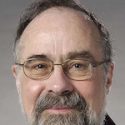UW scientists play key role in discovery of a new particle consistent with Higgs boson
Experiments at the Large Hadron Collider (LHC), aided by scientists from the University of Wisconsin–Madison, have narrowed the search for the elusive Higgs boson, discovering a new particle with a mass in the region of 125 GeV.
Spokespeople for the CMS and ATLAS experiments at the European Organization for Nuclear Research (CERN) announced the results early this morning in presentations at the center’s headquarters near Geneva, Switzerland. The scientists have not yet confirmed whether the new particle is the Higgs boson, but the preliminary data are consistent with Higgs predictions.
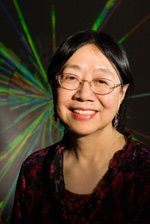
Wu
For the thousands of scientists involved in the ATLAS and CMS experiments at CERN, the result represents a monumental success of the LHC, which has been running since 2009.
“We have been working for many years looking for the Higgs,” says Sau Lan Wu, the Enrico Fermi Professor of Physics at UW–Madison and a member of the ATLAS collaboration. “Finally the effort is coming to fruition. It is very satisfying.”
Finding the Higgs particle has been one of the main goals of the LHC. It was first theorized in 1964 by British physicist Peter Higgs but has eluded experimental observation, leaving a gap in the current Standard Model of particle physics that strives to explain the physical properties of the universe. Through its interactions with other particles, the Higgs boson is thought to be responsible for imparting mass to matter.
Both ATLAS and CMS, the two largest experiments at the LHC, announced discovery of a new particle around the mass region of 125 GeV at a statistical significance level of five sigma, which means there is only a one in 3.5 million probability that the observation is due to random chance.
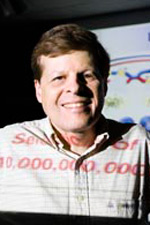
Smith
“After an enormous effort by LHC experimenters, the CERN laboratory and worldwide Grid computing community we are very excited to observe an excess in our data from a new particle consistent with the production of a Higgs boson,” says UW–Madison Bjorn Wiik Professor of Physics Wesley Smith, who plays a lead role in the CMS experiment. “We will need the additional data planned from the running of the LHC until next year to establish if this is indeed the Higgs boson and that we stand at the threshold of a new era of understanding the origins of mass.”
UW-Madison has dozens of scientists involved in the experiments, analysis, and data handling at the LHC, including numerous graduate students and postdoctoral fellows. The Wisconsin groups play key roles in both ATLAS and CMS as well as oversight of computing resources through the Open Science Grid.
Wu has been searching for the Higgs boson for more than two decades. She heads a large research group that has been very active in studying simulated particle collisions and analyzing data coming from ATLAS to look for new particles. Wu herself has a strong history of discovery, having been involved in the identification of the J/psi particle and the gluon in the 1970s.
If the Higgs matches current Standard Model predictions, it can decay into several different combinations of other particles that can be detected by the ATLAS and CMS detectors. Smith’s CMS group contributed substantially to results in two of those combinations, or channels, while Wu’s group on ATLAS has been studying five with a special emphasis on the Higgs to two photon and Higgs to four leptons channels. The latter two channels provide the best resolution of the mass of the new particle, Wu explains.
Why has the Higgs been so hard to find? It is only produced at very high energies, such as those in the Big Bang or generated in a particle collider like the LHC, and it breaks down almost immediately into a shower of other particles. “The probability of making a Higgs is so small that you are looking for one collision out of 10 trillion,” says Smith.
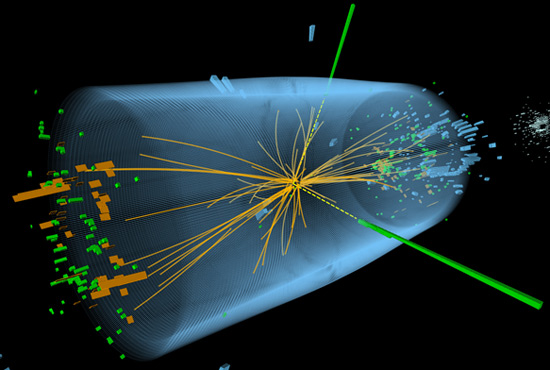
This reconstruction of a particle collision captured by the CMS detector at the Large Hadron Collider shows a new particle first announced on July 4, 2012, that is a strong candidate for the long-sought Higgs boson. UW–Madison researchers have played a large role in the equipment construction, data management and analysis that led to the discovery of the new particle.
Credit: CERN
Sifting through those trillions of events is a major part of Smith’s job at the LHC. His research group oversees the CMS “trigger system” responsible for filtering out the most interesting collisions from a background sea of mundane events, to generate the data used for the results presented today.
During the past few weeks, the excitement and tension have been building at CERN as thousands of physicists pored over the accumulated data, working around the clock to complete their analyses before the 2012 International Conference on High Energy Physics, which begins today in Melbourne, Australia.
Much of that analysis has been aided by the efforts of the Open Science Grid (OSG), which uses distributed high-throughput computing to provide extensive processing resources for LHC scientists, especially those in the U.S. The OSG builds on high-throughput computing principles pioneered at UW–Madison through the Condor project.
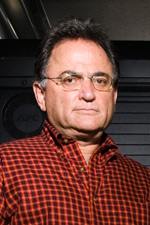
Livny
“By providing so much computing power, the OSG allows LHC scientists to do their work more quickly and efficiently,” says Miron Livny, a UW–Madison professor of computer sciences and principal investigator of the OSG. “Being able to process and analyze the data so quickly improves their ability to make discoveries like this one.”
Though both collaborations are excited about the results announced this morning, they are not ready to identify the particle as the long-sought Higgs just yet. Confirming that something unknown is present is just the first step, Smith says, and they want to be certain that they can rule out every possible non-Higgs explanation.
“There is enough evidence to say there is something in the data that we can’t explain, and it looks like what we’ve been looking for,” Smith says. “But the statistics are not cut and dried. Some of the worst arguments in physics happen not about physics but about statistics.”
With more data — now being collected — and more analysis, the physicists will be able to investigate additional properties of the new particle to clarify whether the observation is actually the Higgs particle predicted by the current Standard Model.
“We still have a lot of work to do to prove whether this is really the Higgs,” says Wu. “And it’s possible we could still find unexpected signals that could imply new physics, that the Standard Model is not the full story. But if we can confirm this is the Higgs, it will be the discovery of the decade.”

On Wisconsin, the alumni magazine for the University of Wisconsin–Madison, published a cover story on the Wisconsin researchers’ quest for the Higgs in its Fall 2008 issue.
If discovery of the Higgs boson is verified, it will trigger a new era of physics in which scientists work to determine just what the Standard Model can tell us about our universe. In particular, the Higgs should inform studies of the source of mass.
“We do not know where most of the mass in the universe is, only about four to five percent,” Smith says. “We have been able to measure the masses of all the particles we have found and their probability of interacting, but we don’t understand why they have those particular masses. If we can understand why they acquire mass, then we can understand our world in a way that is not just empirical.”
And in turn, an improved theoretical understanding will allow physicists to build on the model to develop new testable theories. “As the LHC prepares to increase its energy in coming years, we will be able to push the energy frontier and look for new particles and phenomena that we can only dream of,” Wu says.
After the conclusion of this morning’s presentations, Wu approached Peter Higgs, who was in attendance, to shake his hand. “I have been looking for you for 20 years,” she told him.
Higgs replied, “Now you have found me.”



